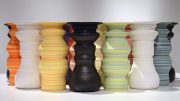From the week of Nov. 15-19, 2010, I lived in a tent in the Gallery of Student Art on campus at the University of Manitoba, in an exhibition called Secondhand Tables and Chairs. The performance was the result of the progression of my work, which evolved from painting, to sculpture and installation, and now to performance. I had previously done a similar installation of a living space, and when considering how to show and adapt the piece to a gallery setting, the main constructive piece of criticism that I received was to live in it.
And so I embarked on this journey into the world of performance art, so bright eyed and bushy tailed, I had no idea what I was getting myself into. One day into the exhibition and I was hyperventilating over the project — I had turned myself into a spectacle. I didn’t anticipate how many visitors to the gallery appeared unaware that performance art isn’t just interpretative dance.
I walked students viewing my work through the piece; it made me question myself constantly. How do I validate my creative process? I invited my classmate Rachel Schappert to come talk with me in the gallery. She took a break from her thesis work to tell me why she decided to start doing performance art.
“It was a natural progression,” she agreed. “I started with two dimensional forms and it just evolved — from sculpture to installation, to live art with a pulse.” She went on to tell me about how she preferred to involve the audience in her work as opposed to forcing them to stand back and just view it. “It is interactive and engaging; if people are willing and open minded, it brings a whole new element to the atmosphere of the piece. They have to allow themselves to enjoy it on a more personal level.” Then she reminded me that the concept of what I was doing is not new, it has been referenced before but just in a different context.
Joseph Beuys is a German artist whose work focuses on concepts of humanism, social philosophy and anthroposophy. After continuously declining invitations to visit and show in America, he finally came to New York in 1974, but did so without ever actually setting a foot on its ground. He was taken by ambulance to the Rene Block Gallery where he spent eight hours over three days alone with a coyote. The performance depended solely on elements created by that situation and added elements that had purely symbolic value. He wanted to isolate and insulate himself, and see nothing of America other than the coyote.
Chris Burden is a Massachusetts born artist who is known for his controversial performances, one of which included being shot in his left arm. In his performance known as “Bed Piece,” he had a bed set up in the gallery space, undressed and laid in it for the duration of the exhibition, only moving to eat and use the bathroom. While he had a euphoric experience, and thoroughly enjoyed his exposure to bed-life, during the performance his audiences were put-off by it, and were frightened by his vulnerability. Public viewers are disturbed when confronted with the artist’s private life.
While exhausting, the vacation I took in the gallery was well worth the stress. Maybe I was not prepared to be made into an art object at the beginning of the week, but at the end I felt like I had conquered it. Relational aesthetics, schmishmational schmishthetics.




